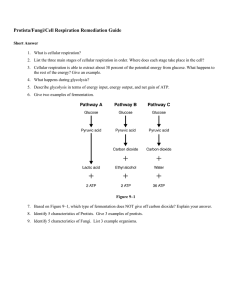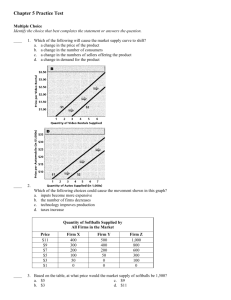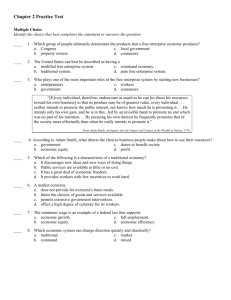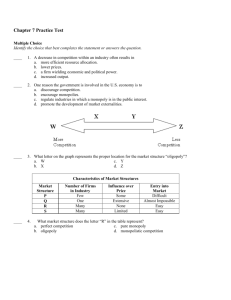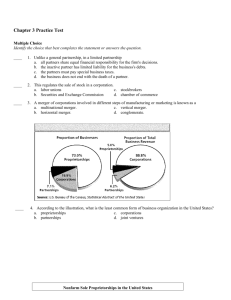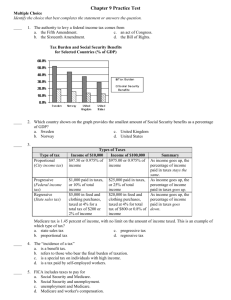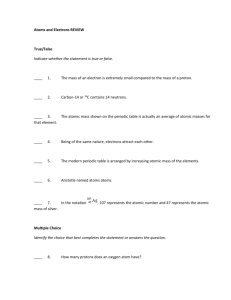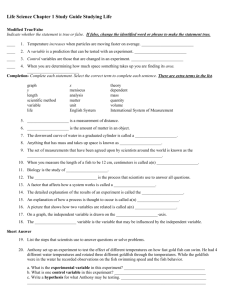Nature of Science
advertisement
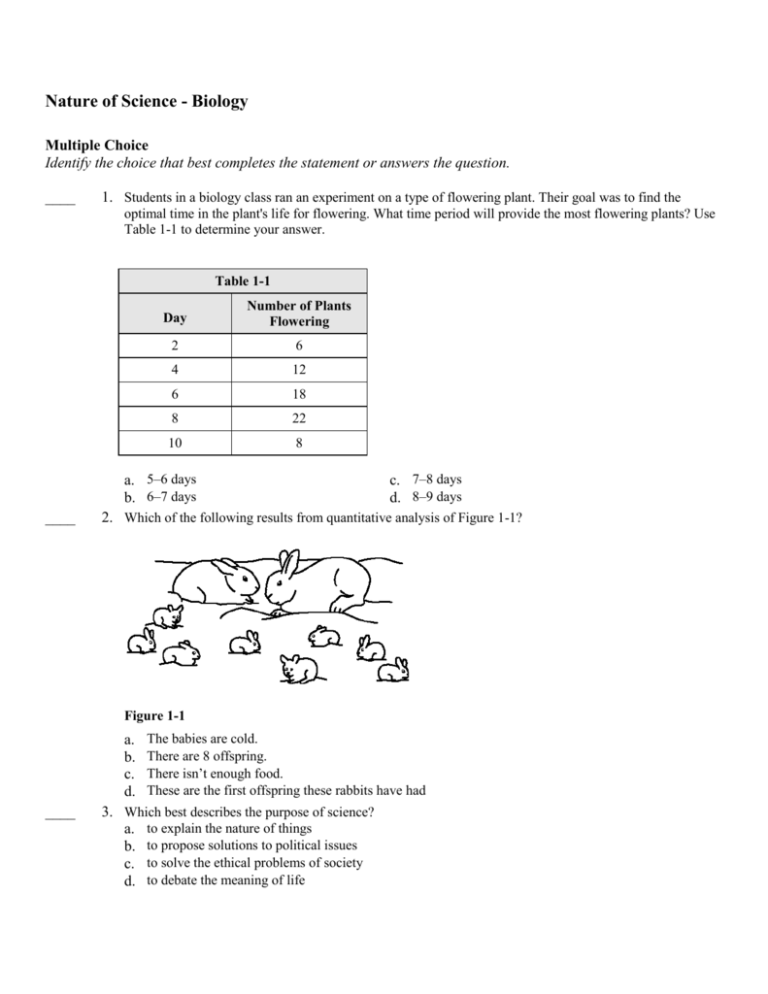
Nature of Science - Biology Multiple Choice Identify the choice that best completes the statement or answers the question. ____ 1. Students in a biology class ran an experiment on a type of flowering plant. Their goal was to find the optimal time in the plant's life for flowering. What time period will provide the most flowering plants? Use Table 1-1 to determine your answer. Table 1-1 Day Number of Plants Flowering 2 6 4 12 6 18 8 22 10 8 a. 5–6 days b. 6–7 days ____ c. 7–8 days d. 8–9 days 2. Which of the following results from quantitative analysis of Figure 1-1? Figure 1-1 a. b. c. d. ____ The babies are cold. There are 8 offspring. There isn’t enough food. These are the first offspring these rabbits have had 3. Which best describes the purpose of science? a. to explain the nature of things b. to propose solutions to political issues c. to solve the ethical problems of society d. to debate the meaning of life ____ 4. A person studying a topic is presented with new information that conflicts with previous findings. What would a scientist do in this situation? a. ignore the new information b. argue against the new information c. evaluate the new information d. keep the new information to himself ____ 5. Tasha is testing the effect of blue-colored light on the growth of tomato plants. Which is the independent variable in this experiment? a. light color b. light intensity c. amount of light d. temperature of light Short Answer The graph in Figure 1-2 shows the three stages in the growth of a corn plant from a seed to a mature plant. Study the graph and then answer the questions. Figure 1-2 6. From Figure 1-2, predict the mass of the plant at day 110. 7. Using Figure 1-2, what might you infer about the height of the plant during the exponential period? 8. Sugar dissolves in, or mixes completely with, water. The solubility of a substance in water is determined by measuring the maximum amount of the substance that dissolves in a given amount of water at a given temperature. HYPOTHESIS: The solubility of sugar in water increases as the temperature of the water decreases. Identify the independent and dependent variables. 9. An electromagnet can be made by wrapping insulated wire around an iron nail and connecting the ends of the wire to a 6-volt battery. HYPOTHESIS: Increasing the number of coils of wire wrapped around the nail increases the strength of the electromagnet, as measured by the number of paper clips the magnet can pick up. Identify the independent and dependent variables. A student noticed that when a dog is cut, the dog periodically licks its wounds. Usually after a few days, the wound begins to heal without ever showing signs of infection. The following steps outline the student's line of reasoning: A. I wonder why the dog's wound doesn't become infected. B. The dog's saliva must prevent the growth of infection-causing bacteria. C. I'll obtain a bacterial culture and grow the same kind of bacteria in two identical culture dishes. Once the bacteria start growing, I'll add dog saliva to only one of the dishes and leave the other alone. I'll cover both dishes. Then I'll observe what happens each day for a week. D. Even after adding the dog saliva to one of the dishes, the bacteria continued to grow in both dishes over the course of the week. However, the bacteria in the treated dish grew more slowly than the bacteria in the untreated dish. E. I think I'll try something else. I'll start with two identical culture dishes, as before, and use the same kind of bacteria in each dish, but this time I'll treat one dish with dog saliva before I add the bacteria. I'll observe what happens each day for a week. 10. Why might the experimental design in step E be a better test of the student's hypothesis than the design used in step C? Problem Table 1-2 11. Make a graph that compares the growth of the plants as shown in Table 1-2. Essay 12. Tyrone knows that using fertilizer will result in more blooms, but wants to know if it will affect a plant’s growth as well. Explain the design of an experiment that would answer this question. Nature of Science - Biology Answer Section MULTIPLE CHOICE 1. ANS: C Between 6 and 8 days the number of flowering plants is highest. Feedback A B C D That's close, but there are a greater number of flowering plants at a different time. See page 20 for more information on analyzing graphs. That's correct! Try again. PTS: 1 STA: II.1.3 2. ANS: B DIF: Bloom's Level D TOP: 1-9 REF: 20 Quantitative data relates to numerical data; therefore the answer choice, which includes a number is correct. Feedback A B C D Numerical information includes numbers. That's correct! See page 19 for more information. Try again. PTS: 1 STA: II.1.3 3. ANS: A DIF: Bloom's Level D TOP: 1-9 REF: 19 Science seeks to explain things. Feedback A B C D That's correct! See page 11 for more information. That's not quite right. Try again. PTS: 1 TOP: 1-4 4. ANS: C DIF: Bloom's Level E REF: 11 Scientists evaluate new information, especially if it conflicts with their own findings. Feedback A B C D Science seeks to explain all information. See pages 12–13 for more information. That's correct! Try again. PTS: 1 NAT: IS_2e 5. ANS: A DIF: Bloom's Level E TOP: 1-5 REF: 12–13 She is testing the effect of the color of light on the plants’ growth; therefore, light color is the independent variable. Feedback A B C D That's correct! See page 19 for more information. That's not quite it. Try again. PTS: 1 NAT: IS_1b DIF: Bloom's Level C STA: I.1.2 TOP: 1-8 REF: 19 DIF: Bloom's Level D TOP: 1-9 REF: 20 SHORT ANSWER 6. ANS: about 81 g PTS: 1 STA: II.1.3 7. ANS: The height of the plant increases with the gain in mass. PTS: 1 TOP: 1-9 8. ANS: DIF: Bloom's Level D REF: 20 Independent variable: temperature of the water; dependent variable: amount of sugar that dissolves. PTS: 1 NAT: IS_1b 9. ANS: DIF: Bloom's Level C STA: I.1.2 TOP: 1-8 REF: 19 Independent variable: number of coils of wire; dependent variable: number of paper clips lifted by the magnet. PTS: 1 NAT: IS_1b 10. ANS: DIF: Bloom's Level C STA: II.1.3 TOP: 1-8 REF: 19 Answers may vary. The hypothesis is framed around the idea that the dog's saliva prevents initial bacterial growth, so testing to see whether bacteria begin to grow in the presence of dog saliva might be a more accurate test of the hypothesis than testing to see if the saliva destroys or slows down the growth of bacterial colonies that are already established. PTS: 1 NAT: IS_1b DIF: Bloom's Level F STA: II.1.3 TOP: 1-9 REF: 16–19 PROBLEM 11. ANS: Graph should be two lines with time (days) on the horizontal axis and height (cm) on the vertical axis. See example below. Solution 1-1 PTS: 1 NAT: IS_1c DIF: Bloom's Level E TOP: 1-8 REF: 18–20 ESSAY 12. ANS: Answers may vary. The experiment should include at least two groups of plants. One of the groups, the control, should not receive any fertilizer, but in all other ways should be treated in the same way as the other group(s). The amount of fertilizer is the independent variable. The other factors, such as amount of water, sunlight, and so on, are constants. The other group should receive some measured amount of fertilizer for the period of the experiment. It would be possible to have more than one experimental group with different amounts of fertilizer. The dependent variable, plant growth, should be measured at the end of the period of the experiment and compared between the control group and the experimental groups to answer the question. PTS: 1 NAT: IS_1b DIF: Bloom's Level E STA: I.1.2 TOP: 1-8 REF: 19
